Selection repertoire
Please refer to the MHIVC application video instructions here.
It is important you ensure the five selection items are labelled as required and submitted in the order outlined below.
1. One of the following selections from Bach’s unaccompanied Sonatas and Partitas:
- Adagio and Fuga from Sonata No 1 in G minor
- Grave and Fuga from Sonata No 2 in A minor
- Adagio and Fuga from Sonata No 3 in C major
- Ciaccona from Partita No 2 in D minor
2. Paganini – One Caprice from Op 1
3. Mozart – One of the following first movements with piano accompaniment:
- Allegro from Concerto No 3 in G major, K 216
- Allegrofrom Concerto No 4 in D major, K 218
- Allegro Aperto from Concerto No 5 in A major, K 219
Please label your Mozart recording with the cadenza composer. It is not mandatory, but competitors are encouraged to supply their own cadenza.
4. One movement from one of the following Sonatas with piano accompaniment:
- Beethoven Sonata No 7 Op 30, No 2
- Beethoven Sonata No 8 Op 30, No 3
- Brahms Sonata No 1 in G major Op 78
- Brahms Sonata No 3 in D minor Op 108
- Debussy Sonata for violin and piano
- Fauré Sonata in A major Op 13
- Franck Sonata in A major
- Grieg Sonata No 3, Op 45
- Prokofieff Sonata No 1 in F minor
- Prokofieff Sonata No 2 in D major
- Ravel Sonata for violin and piano
5. Ad Libitum – Work of Applicant’s choice, solo or with piano accompaniment only.
Applicants are required to provide a full score in their application materials and are strongly encouraged to introduce their work on camera (explaining why they selected it and why it is meaningful to them) prior to recording it.
Ad libitum means “according to pleasure”. Each applicant has the opportunity to demonstrate to the Selection Panel works that personally resonates with them; that demonstrates a particular talent or enthusiasm, something in which they truly excel, and which gives pleasure to the performer and the audience.
Rounds I and II - New Zealand live rounds
Competitors’ programmes are performed in two halves – Rounds I and II – before the international judges determine the six violinists who will progress to Round III. The maximum allowable time for Rounds I and II combined is 90 minutes (minimum 80 minutes) for each competitor, inclusive of stage entrance, tuning, bowing and introducing works to the audience.
Competitors are encouraged to present repertoire that exhibits a broad stylistic range and are required to include the following works in their programmes:
1. One of the following selections from Bach’s unaccompanied Sonatas and Partita (by memory):
- Adagio and Fuga from Sonata No 1 in G minor
- Grave and Fuga from Sonata No 2 in A minor
- Adagio and Fuga from Sonata No 3 in C major
This selection must be performed as the first work on the competitors’ programme (e.g Round I). The order of the rest of the round is at the competitors’ discretion.
2. One Caprice from Op 1 of Paganini (by memory)
3. Commissioned piece for solo violin by New Zealand composer Salina Fisher (maximum five minutes duration). This work will be made available on 1 April 2026.
4. One of the following Sonatas with piano:
- Beethoven Sonata No 7 Op 30, No 2
- Beethoven Sonata No 8 Op 30, No 3
- Brahms Sonata No 1 in G major Op 78
- Brahms Sonata No 3 in D minor Op 108
- Debussy Sonata for violin and piano
- Fauré Sonata in A major Op 13
- Franck Sonata in A major
- Grieg Sonata No 3, Op 45
- Prokofieff Sonata No 1 in F minor
- Prokofieff Sonata No 2 in D major
- Ravel Sonata for violin and piano
5. Ad Libitum
Work of Competitor’s choice (please refer FAQ on the Competition’s website).
The following must be observed:
- Each competitor is required to introduce at least one of the work from the stage prior during their programme
- Any costs associated with collaborating artists other than the Competition pianists will be borne by the Competitor.
- Any costs associated with hiring, delivery and preparation of any instruments, other than piano, will be borne by the Competitor,
- Each Competitor receives a maximum of 120 minutes’ rehearsal with their assigned pianist to prepare their full Queenstown programme.
- Competitors are required to provide all piano scores to the Competition by 1 February.
All additional works are the competitor’s own choice subject to final approval of the submitted programme by the MHIVC. Final approval of quarter-finalists’ programmes will be given by the Competition’s management by 20 February 2026.
Round III - Semi-Finals
Six competitors will perform, in its entirety, one of the following piano quintets (Barenreiter edition, if available):
- Dvořák Piano Quintet No 2 in A major, Op 81
- Schumann Piano Quintet, Op 44
- Shostakovich Piano Quintet in G minor, Op 57
Each Competitor receives a maximum of 90 minutes’ rehearsal with the Round III collaborative artists.
Grand Final
The three finalists will each perform, in its entirety, one of the following concertos, with orchestral accompaniment by the Auckland Philharmonia:
- Bartók Concerto No 2
- Beethoven Violin Concerto
- Brahms Concerto in D major
- Britten Concerto
- Dvořák Concerto in A major
- Elgar Concerto in B minor Op 61
- Mendelssohn Concerto in E minor
- Nielsen Violin Concerto
- Prokofieff Concerto No 1 in D major Op 19
- Prokofieff Concerto No 2 in G minor Op 63
- Sibelius Concerto in D minor
- Shostakovich Concerto in A minor Op 99
- Tchaikovsky Concerto in D major
- Walton Violin Concerto
Tour Partners
Exceptional collegiality from our presenting partners


